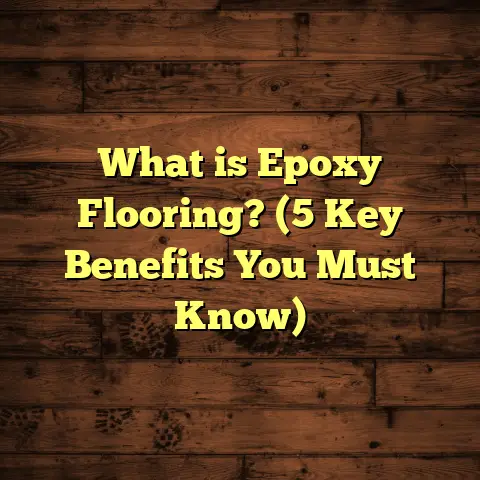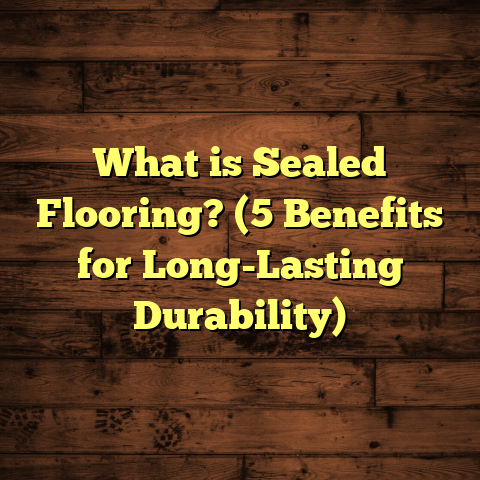What is Vinyl Flooring? (5 Benefits for Modern Homes)
If you’ve binged on shows like Stranger Things or Mad Men, you might have noticed those retro kitchens and funky basements with slick, shiny floors that look both durable and stylish. Well, many of those floors are vinyl—yeah, that material that’s been around for decades but somehow keeps reinventing itself. I remember the first time I worked with vinyl flooring on a client’s home; I wasn’t sure how it’d hold up, but that project completely changed my view. Let me walk you through what vinyl flooring really is and why it’s become a favorite for modern homes like yours.
What Is Vinyl Flooring?
Vinyl flooring is a synthetic flooring material made primarily from polyvinyl chloride (PVC) resin. But let’s skip the chemical jargon—think of vinyl as a type of plastic that’s been engineered to mimic natural flooring like wood and stone, but with some pretty neat perks. It usually comes in sheets, tiles, or planks, and can be installed in almost any room of your house.
When I first started installing vinyl floors, I was amazed at how versatile it was. It can have a soft, cushioned feel or be extremely tough depending on the thickness and wear layer. Plus, thanks to advances in printing technology, the designs are incredibly realistic now. You can get a vinyl floor that looks like hardwood or marble without the cost or maintenance hassle.
Let me give you an example: On one job, a family wanted the look of oak hardwood but had two young kids and a dog. Hardwood would’ve scratched and dented quickly. Vinyl plank flooring gave them the aesthetic they wanted with durability that stood up to their busy lifestyle.
1. Durability That Handles Life’s Messes
When clients ask me for advice on flooring options that last, vinyl is near the top of my list. This material really takes a beating and keeps looking good.
Why Durability Matters
Think about your life at home for a second. Kids running around with toys, pets scratching or tracking mud inside, spills from dinners or art projects—it’s not just about looking good, but surviving everyday chaos.
Vinyl’s tough wear layer shields it from scratches, scuffs, and stains better than many other flooring types.
My Experience With Vinyl Durability
I once installed vinyl plank flooring in a family home with two toddlers and a golden retriever. Within six months, there were plenty of spills and scratches—but guess what? The floor still looked fantastic. No dents or discoloration.
This durability is backed by data: vinyl floors can last 10-20 years if you care for them properly. That lifespan competes well with laminate and even some hardwoods under heavy use.
Tips to Maximize Vinyl Durability
- Choose a thick wear layer: Look for 12 mil or higher in residential spaces.
- Avoid dragging heavy furniture: Use furniture pads.
- Clean spills quickly: Though vinyl resists stains, prompt cleanup helps.
- Use proper cleaning products: Avoid harsh chemicals that might degrade the top layer.
Case Study: Commercial Durability
I worked on a small café renovation where the owners chose commercial-grade vinyl flooring. The floor handled hundreds of foot traffic daily without showing wear after two years. It stood up to dropped dishes and repeated mopping with no issues.
2. Water Resistance That Keeps You Worry-Free
Water damage is one of the biggest enemies of floors. Hardwood warps, laminate swells, and carpets soak up moisture. Vinyl? Not so much.
How Water Resistance Helps
Bathrooms, kitchens, basements—they’re prone to spills, humidity, or even flooding sometimes. Vinyl’s water resistance means no swelling or warping if liquids are spilled or tracked in.
In fact, many vinyl planks and tiles are fully waterproof now.
Real-Life Flood Story
A few years back, I helped a client whose basement flooded after heavy rains. The entire floor was vinyl sheet flooring. Once the water was pumped out, the floor dried quickly with no warping or damage.
This saved them thousands in repairs compared to if they had hardwood or laminate down there.
What To Look For If You Want Waterproof Vinyl
- Check product specs: Make sure it’s labeled “waterproof” not just “water-resistant.”
- Seamless sheet vinyl: Great for bathrooms where moisture is constant.
- Click-lock vinyl planks: Many are waterproof but watch for seams that might allow water through.
Maintenance Tips for Water Resistance
- Wipe up puddles quickly.
- Use mats near sinks or entryways.
- Avoid wax-based cleaners that trap moisture underfoot.
3. Comfortable Underfoot and Easy to Maintain
Ever stood on tile or hardwood all day? It can be rough on your feet and legs. Vinyl floors have this amazing soft feel—like a little cushion under your shoes.
Why Comfort Matters
If you cook a lot or spend time standing in your kitchen or laundry room, having a floor that eases pressure on your joints is a blessing.
Many vinyl products come with padded backing or can be installed over foam underlayment to add extra comfort.
Cleaning Made Simple
One thing I love about vinyl is how simple it is to keep clean:
- Sweep regularly to remove grit.
- Mop occasionally with mild soap and water.
- Avoid abrasive scrubbers or strong chemicals.
Compared to hardwoods that need special cleaners or tiles that require grout cleaning, vinyl is low maintenance.
Client Story: Elderly Comfort
I installed vinyl flooring for an elderly couple who complained about tiring feet on tile floors. They told me how much easier it was to stand during cooking and cleaning after switching to vinyl. That story stuck with me because comfort often gets overlooked but makes a huge difference in daily life.
4. Affordable Style Without Sacrificing Looks
Vinyl flooring has made huge strides in style over recent years. There’s no longer any need to settle for cheap-looking sheets from decades ago.
Design Variety
You can find vinyl that mimics:
- Rich hardwood grains from oak to walnut
- Marble and stone textures
- Intricate tile patterns
- Rustic wood planks with knots and grooves
The technology behind printing and embossing these surfaces has become extremely advanced.
Cost Comparison
Here’s what I’ve seen in my projects:
| Flooring Type | Average Cost per Sq Ft Installed |
|---|---|
| Vinyl Flooring | $3 – $7 |
| Hardwood Flooring | $8 – $15 |
| Laminate Flooring | $4 – $8 |
| Ceramic Tile | $7 – $15 |
Vinyl gives you designer looks without breaking the bank.
Budget-Friendly Renovations
I recently helped a client who wanted an upscale look in their rental property but had strict budget limits. We chose luxury vinyl plank flooring that looked fantastic and stayed within their price range. The landlord loved how easy it was to clean between tenants as well.
5. Simple Installation Makes Renovations Faster
One of the biggest headaches with flooring projects is installation time and complexity. Some materials require special subfloors, adhesives, or professional crews that drive costs up.
Vinyl simplifies this dramatically.
Installation Methods I Use Frequently
- Peel-and-stick tiles: Great for small DIY projects.
- Click-lock planks: Floating floor system installs quickly without glue.
- Sheet vinyl with adhesive: Professional jobs where seamless floors are needed.
Why Faster Installation Matters
Less time installing means less disruption for homeowners. It also means fewer labor hours required—a big factor in total project cost.
For instance, I once installed click-lock vinyl planks in a 500 sq ft living room over two days, including prep work. The client was thrilled to have their new floor done so quickly.
How FloorTally Helps Me Plan Installations
When planning projects, I use tools like FloorTally to estimate installation costs quickly based on local labor rates and material prices.
It helps me:
- Calculate total material needs while including waste factors
- Get accurate labor estimates
- Visualize overall project costs for clients upfront
This way, I avoid surprises mid-project and keep everything on track budget-wise.
More Benefits: Sound Insulation, Allergy-Friendliness & Eco Options
Sound Reduction
Vinyl floors absorb sound better than tile or hardwood. So if noise reduction is important—say you live in an apartment building—vinyl can give quieter footsteps and less echo.
Allergy-Friendly Properties
Vinyl doesn’t trap dust or allergens like carpet does. For people with allergies or asthma, this can improve indoor air quality significantly.
Eco-Friendly Choices Are Growing
There are now more environmentally conscious vinyl options with recycled content and low-VOC (volatile organic compound) emissions for healthier homes.
Common Questions About Vinyl Flooring
I’m often asked some recurring questions from clients who want to be sure they’re making the right choice:
Will Vinyl Flooring Feel Cheap?
Not at all if you pick quality products with textured finishes. The tactile feel can be surprisingly natural underfoot.
Can Vinyl Flooring Be Used Outdoors?
No—vinyl isn’t designed to withstand direct sunlight or outdoor weather conditions for long periods.
How Do I Repair Damaged Vinyl?
Small scratches can often be buffed out or covered with repair kits. Larger damage may require replacing individual tiles or planks if your product allows it.
Does Vinyl Flooring Fade Over Time?
Good quality vinyl has UV inhibitors that prevent fading under normal indoor light exposure.
How to Care for Your Vinyl Floor Like a Pro
To keep your vinyl floor looking fresh for years:
- Sweep daily or every few days
- Mop weekly with mild cleaner
- Avoid dragging heavy furniture without protection
- Use felt pads on chair legs
- Clean spills immediately
- Replace damaged tiles/planks early before damage spreads
Final Thoughts From My Experience
After working hands-on with various flooring materials over many years:
Vinyl flooring consistently stands out as an excellent choice for modern homes needing durability, style versatility, comfort, water resistance, and affordability—all wrapped into one package.
If you’re considering options for your kitchen, bathroom, basement, or living spaces—and especially if you want something practical yet attractive—vinyl deserves serious attention.
Have you explored vinyl flooring before? What do you think? If you want advice tailored to your home’s needs or help estimating costs (I’m happy to share how I use tools like FloorTally), just ask!
Would you like me to include specific product recommendations or step-by-step installation guidance next? Or maybe deeper info on how different vinyl types compare? Let me know!





